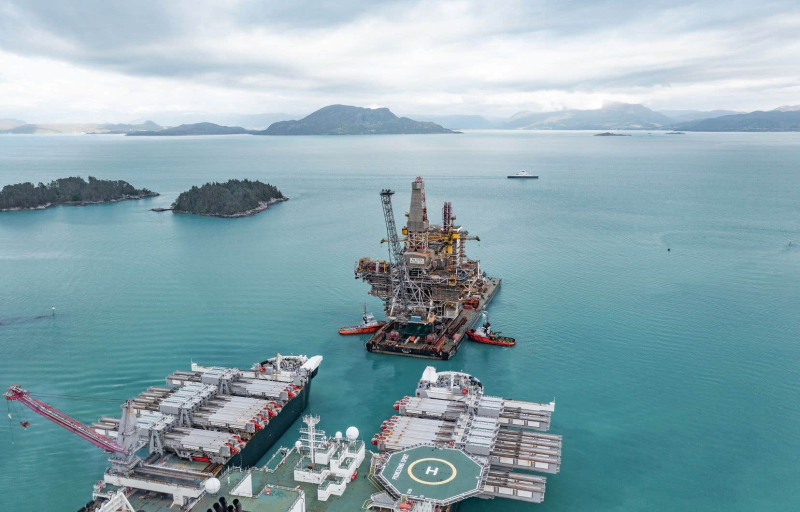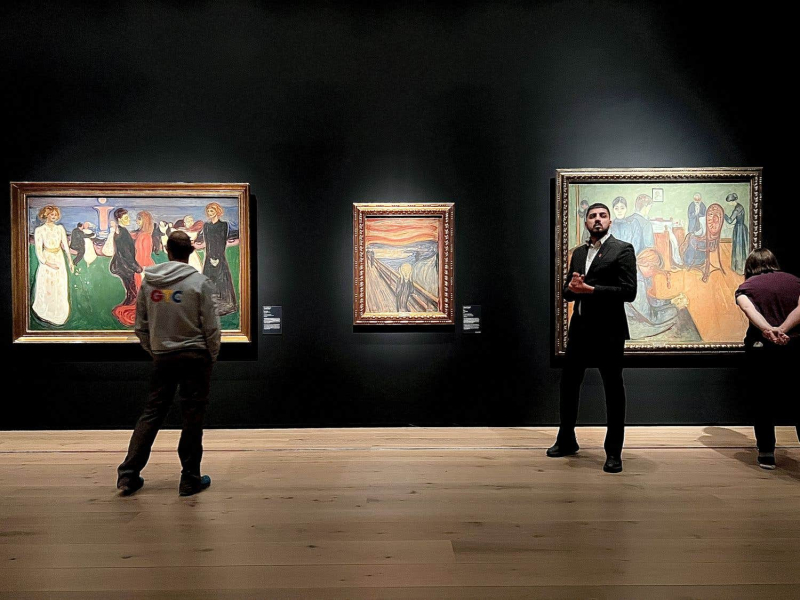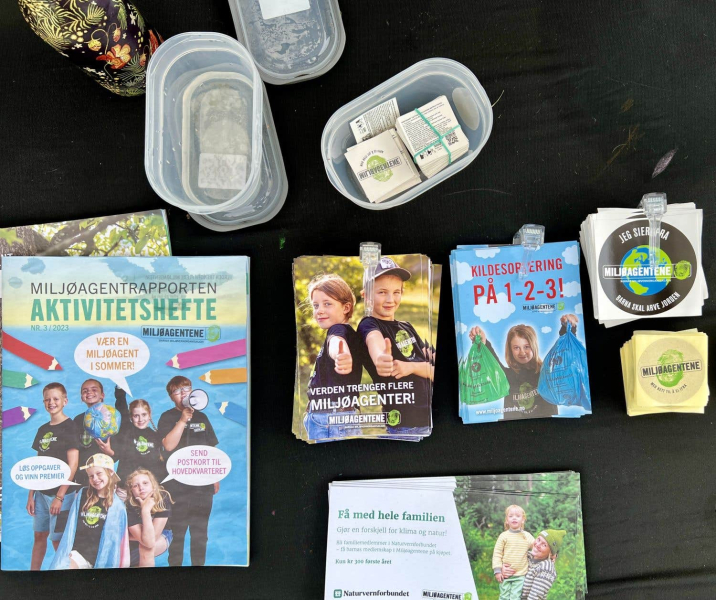
Photo: AFP Over the past few months, Hallvard has taken part in the writing of the Children's Report on Climate and Environment 2023, the findings of which he will present to the “adults” that he will meet at COP28 in Dubai in the coming days.
The room on the second floor of the National Museum in Oslo is plunged into soft darkness. The cry, by Edvard Munch, hangs there in silence. A security guard is standing nearby. He is on high alert.
For good reason, climate activists from the group Stopp oljeletinga (Stop oil exploration) tried, a year ago, to stick their hands together the protective glass plate covering the iconic canvas, without success.

Photo: Marco Bélair-Cirino
In doing so, they have drawn attention to the troubled relationship Norwegians have with oil and gas: they embrace fossil fuels because they make their fortune; they reject fossil fuels because they will lead to climate catastrophe. Hallvard Hauge, Andreas Randøy and Emanuel Smári Nielsen are each trying, in their own way, to convince political decision-makers to put an end to this toxic relationship. Le Devoir met them in the Norwegian capital.
Hallvard Hauge said he initially found it “a bit strange” that activists were trying to glue their hands to the Munch's anxiety-inducing cry. “Now I understand why they did that,” he says at the age of 11, “in the living room of the painting-colored apartment where he lives with his parents. They were trying to get the attention of politicians. »
The young environmental activist, or ecoagent, tries with other children to convince Norwegian politicians to put an end to oil exploration, failing which extreme climatic events – droughts, floods, storms, landslides, etc. -it — will intensify. “When I watch the news, I'm a little scared,” he admits, while holding up the front page of the “Junior” section of the newspaper Aftenposten on which we can see damage done by the storm Hansover the summer.
Over the past few months, Hallvard has been involved in writing the Children's Climate and Environment Report 2023, which he will present conclusions to the “adults” he will meet at COP28 in Dubai in the coming days.
In particular, Norwegian leaders must ensure that greenhouse gas (GHG) emissions are reduced, stop searching for new oil deposits, use oil at a pace that respects the Paris Agreement, and focus on renewable energies, we can read in the document illustrated with children's drawings, including that of a half-charred Earth holding a poster bearing the following message: “I believe in Santa Claus more than in politicians. »
“It was Norwegian adults who decided that Norway should emit so much [GHG], but it’s children who have to bear the consequences. It is unfair. One of the first things we learn is to be kind, to think of others. We must always remember that what we do now affects others,” wrote the eight authors, including Hallvard, after surveying more than a thousand Norwegians aged 8 to 19 about climate challenges and environmental issues.
—Are politicians listening to you?
— Some of them are listening. But most don't listen to us, replies Hallvard, wearing a t-shirt emblazoned with the ecoagents logo.
Barely 12% of the country's young people feel like they influence politicians on issues. climate and environmental issues. “We are told that we are next, the ones to invest in and the ones who will be able to stop climate change. But how can we do that if no one listens to us? » ask the members of the Norwegian Child Climate Expert Group in their final report.
— If they don't listen to us, extreme weather phenomena will increase, reiterates Hallvard.
Approaching power
Retired eco-agent Emanuel Smári Nielsen chose to join the Labor Party's youth wing to convince the country's Prime Minister, Jonas Gahr Støre, and his government to accelerate the transition. Even though “there are Teslas everywhere” — among new cars sold in 2022, 80% were electric and 93% were electric or hybrid — Norwegians, including Labor, are not doing enough to reduce GHG emissions, he says bluntly. “I belong to the youth wing and so I can say what I want about it,” says the teenager, smirking, in the heart of Frogner Park. “People worry about driving electric and recycling, but we can't do too much to reduce our consumption of fossil fuels,” he adds, standing on the wet lawn.
Behind him, children wander from kiosk to kiosk, stopping sometimes at the Peppa Pig one, sometimes at the eco-agents one. The continuous sound of a fountain mixes with the voice of singer Katy Perry broadcast from a loudspeaker: “Boom, boom, boom /Even brighter than the moon, moon, moon /It's always been inside of you, you, you /And now it's time to let it through…” It's the festival A walk in the park .
Emanuel also calls for an end to oil and gas exploration off the Norwegian coast. “We can maintain current projects, but not look for new oil and gas deposits,” he argues, not without knowing that the values of gas and crude oil exports have reached $170 and $70 billion, respectively. Canadians only in 2022. For a country with some 5.7 million inhabitants, compared to 8.9 million for Quebec, this is enormous.
The Government-Foreign Pension Fund, which is the sovereign wealth fund in which revenues from the exploitation of the Norwegian continental shelf have been partly stored, arouses envy.
“If Norway does not succeed, who can? asks Emanuel, before returning to the eco-agents kiosk. We have the resources. We have the money. We have the people! »
Take more direct actions
“It’s time to be more radical than ever. We need more action, more activism, more civil disobedience, not less,” says climate and energy activist Andreas Randøy at Greenpeace Norway headquarters in Oslo.
“Save the Arctic”, “oil fuels war”… Banners and posters hung around it recall some of the campaigns led by the group — the stunt at the National Museum does not was not one of them.

Photo: Marco Bélair-Cirino
According to Andreas, it is “more effective to take more direct actions” against the “enemy”, i.e. “the lobby of fossil fuel industry and the politicians who encourage it.” “So I can think of a hundred actions I would do before sticking to the Screamof Munch, not for ethical considerations, but simply from a tactical point of view,” says the 26-year-old, who is “not afraid to take actions that many consider radical.”
As proof, he did not hesitate to block the main entrance to a garden party organized on the sidelines of the last “high-level” conference of the oil and gas industry. Offshore Northern Seas gas company in Stavanger.
Greenpeace has also launched, with other groups, a legal attack against the authorization given to oil projects in the pipeline of the giant Equinor.
“We sometimes win,” emphasizes Andreas, recalling the shutdown of the Wisting oil field project, far to the north, in the Barents Sea.
“Sometimes,” the cries are heard .
This report was financed with the support of the Transat-Le Devoir International Journalism Fund.
Also read
This text is published via our Perspectives section.

